
If you’re one of the more than 4.5 billion people who use the internet, you are probably familiar with online shopping. You might have been drawn to the convenience or saw a personalized ad that you just had to click. But there’s another major side to online shopping that we decided to explore: online reviews.
Brick-and-mortar stores rarely provide product reviews. Online, however, customers are free to sing a product’s praises or leave brutally honest feedback for everyone to see.
To see how reviews impact both consumers and small businesses, we did three things: First, we used Fakespot’s online review analysis to see which percentages of reviews on popular sites were fake; second, we surveyed consumers about their online reviewing behaviors; and lastly, we surveyed those involved with the marketing efforts of small businesses to see how reviews impact their daily schedules, as well as their bottom lines. Continue reading to see what all of this revealed.
Table of Contents
Spot the Fake
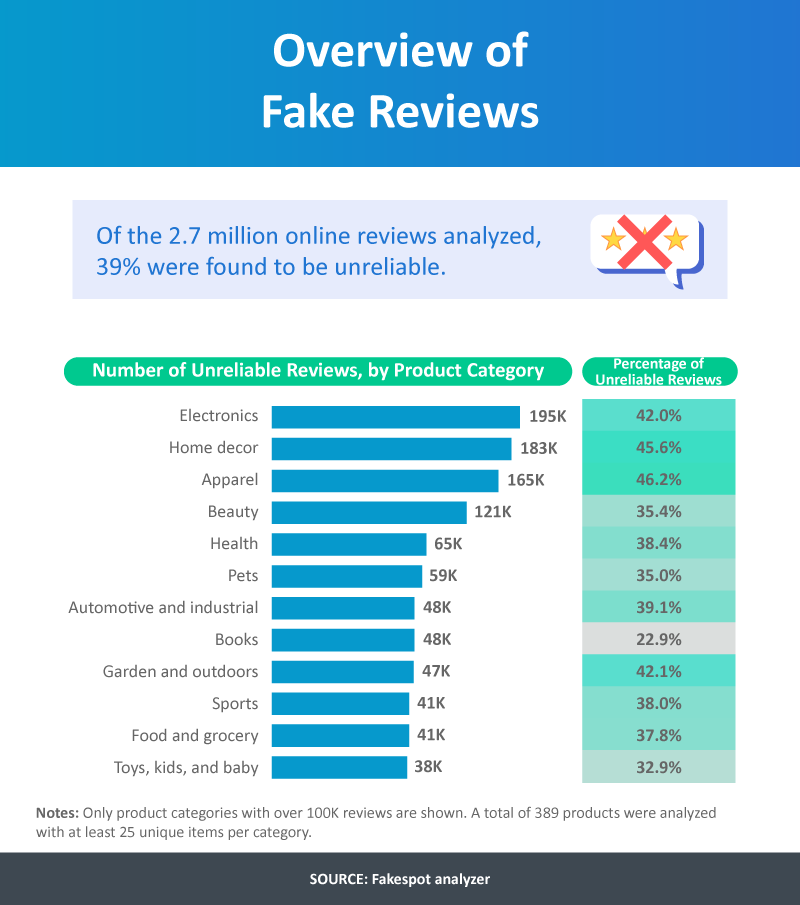
The fake review economy is, unfortunately, pretty big: Of the 2.7 million online reviews that we analyzed, 39% revealed themselves to be unreliable.
As far as total numbers were concerned, the electronics category was hit hardest by fake reviews. In fact, 195,000 of the electronics reviews analyzed were fake, which amounted to 42% of all electronics reviews. However, this was surpassed by the apparel category, where reviews were unreliable 46.2% of the time.
Arguably, apparel may be the most difficult category to review online, as it’s impossible to know how clothes will work for other shoppers. Something that worked well for one body may not necessarily work well for others. That said, a fake review – one claiming to love a pair of pants that were never actually purchased – wouldn’t help anybody, regardless of shape or size.
Where electronics are concerned, however, reviews might be more helpful. Your personal experience with a device can even guide other buyers’ purchasing decisions – unless your review is completely fake.
Unfortunately, 24% of all online products analyzed had more than 50% of their reviews deemed unreliable by Fakespot. And sometimes, these reviews were explicitly requested, as 15% of respondents admitted they had been asked to write a review for a product they had neither purchased nor used.
Reading the Reviews
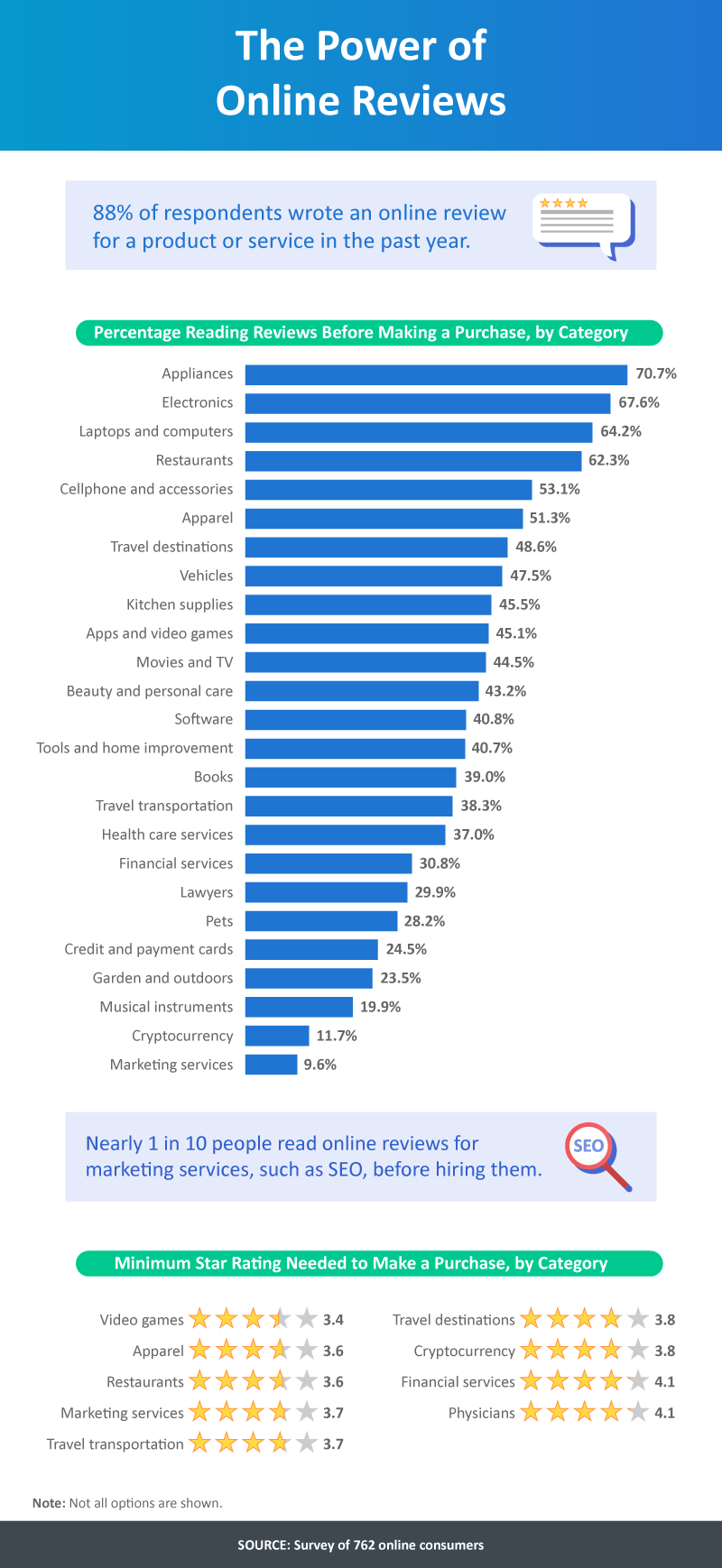
In the past year, 88% of people surveyed had written at least one online review. But people aren’t only writing reviews – they’re using them to decide whether to purchase a product. In fact, 70% of people would pay more money for products or services with higher review ratings.
Certain reviews, however, are seemingly more likely to influence purchasing choices than others. Appliances, electronics, laptops, and computers, and restaurants were the top four review categories that customers read prior to making a purchase decision. Since these categories are often some of the most expensive, customers might be inclined to concern themselves with the reviews of other customers. Previous studies have also shown that the more expensive an item, the more reviews it will receive, so reading reviews seems like an easy and obvious choice.
Restaurants, however, have a different type of cost beyond money – time. Perhaps customers want to spare themselves from a poor dining experience if possible. Moreover, restaurant reviews may help patrons know what to order or even learn the best times to visit. All of this is possible when reading a few customer reviews.
Proof of Product
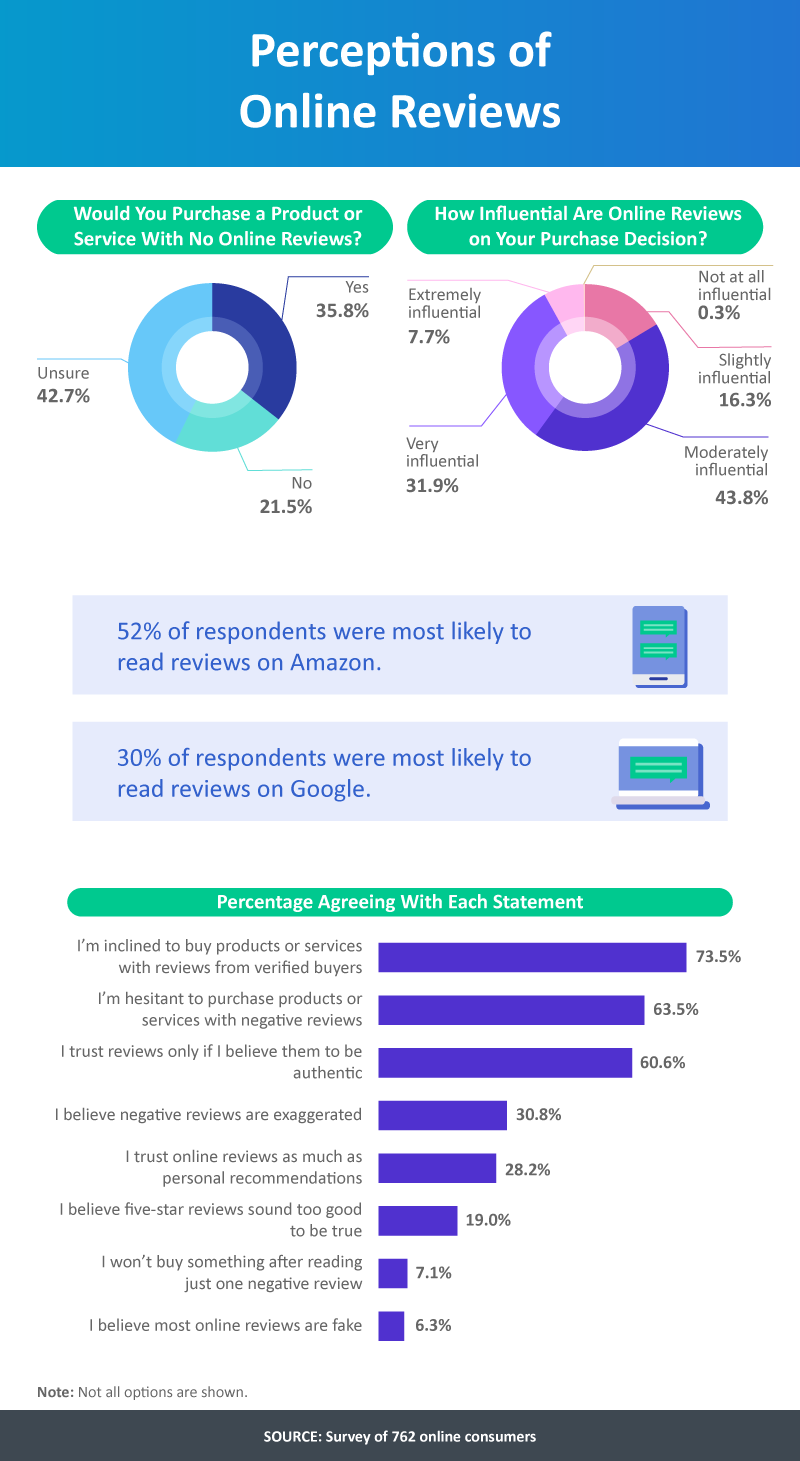
Would you purchase a product or service with no online reviews? Most respondents said no or that they were unsure. Only 35.8% of online consumers would complete a purchase sans review. But many took it a step further.
Nearly 74% of respondents wanted more than just any review – they were more inclined to buy products or services with reviews from verified buyers. Less than 64% were also hesitant to buy products or services with negative reviews. While an honest negative review may save customers a lot of time and trouble, a fake negative review can cause undeserved havoc on small business owners. 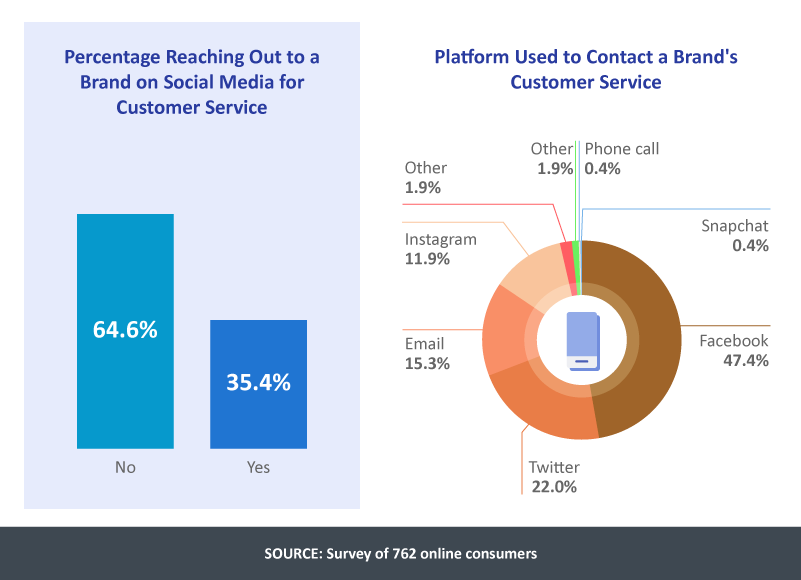
Online reviews, however, weren’t the only form of communication between businesses and customers. Thirty-five percent of respondents had reached out to a brand for customer service using social media. Most often, they used Facebook (47.4%) and Twitter (22%).
Customer service through social media is a new and interesting phenomenon that can provide enormous opportunities and risks for businesses. For example, failing to respond to a customer service request online can result in a digital review or complaint, yet resolving an issue online can often help a customer in the most convenient way possible.
Marketing M.O.s
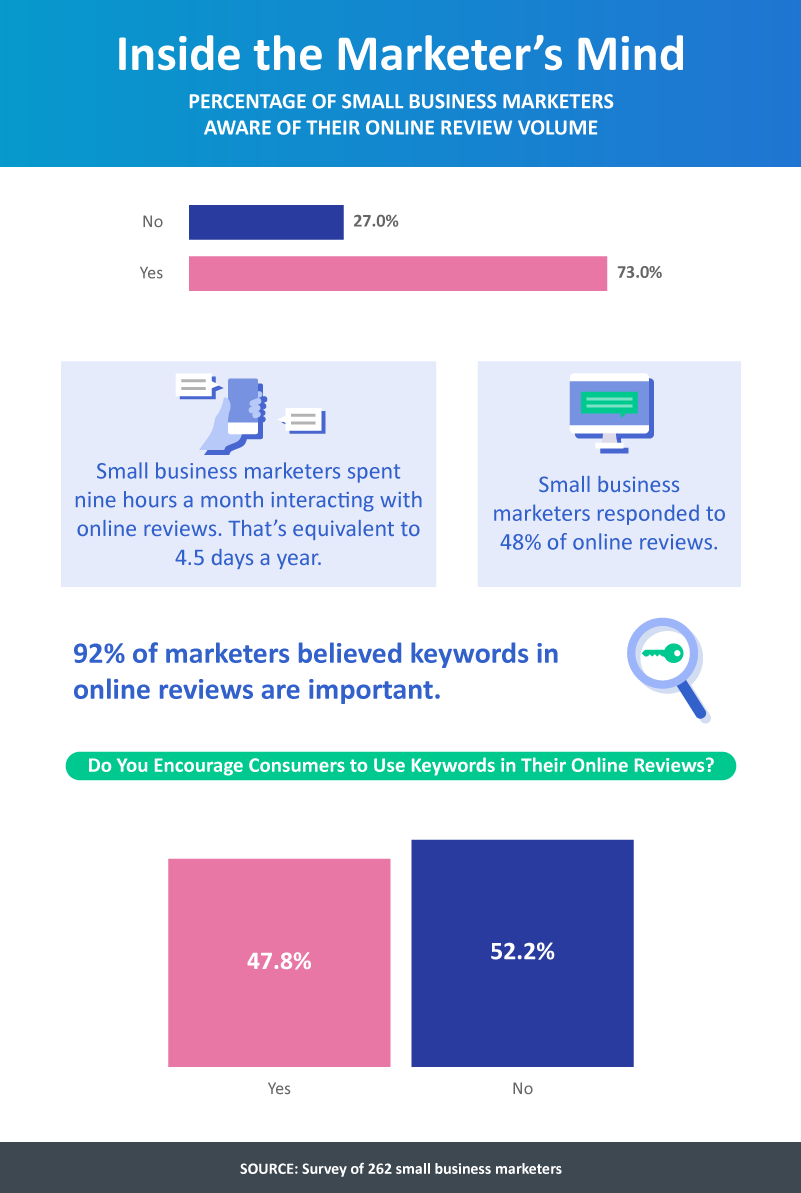
A good marketing team will likely understand just how impactful and important online reviews are for small businesses. Seventy-three percent of small business marketers surveyed were aware of their online review volume. On average, small business marketers spent nine hours each month interacting with online reviews, equating to 4.5 days every year. They even managed to respond to 48% of the online reviews they received.
Many marketers also considered the importance of keywords in online reviews. A keyword is a word or phrase that describes the content of your post the best. It’s essentially the search term a person would likely use when coming across your product. Ninety-two percent of small business marketers believed keywords in online reviews were important. Another 47.8% even encouraged customers to use keywords when reviewing their products online. Unfortunately, some were dishonest in their approach: 18% admitted to asking people to write fake reviews. Although their products might be great, a fake review is deliberately misleading.
Review Results
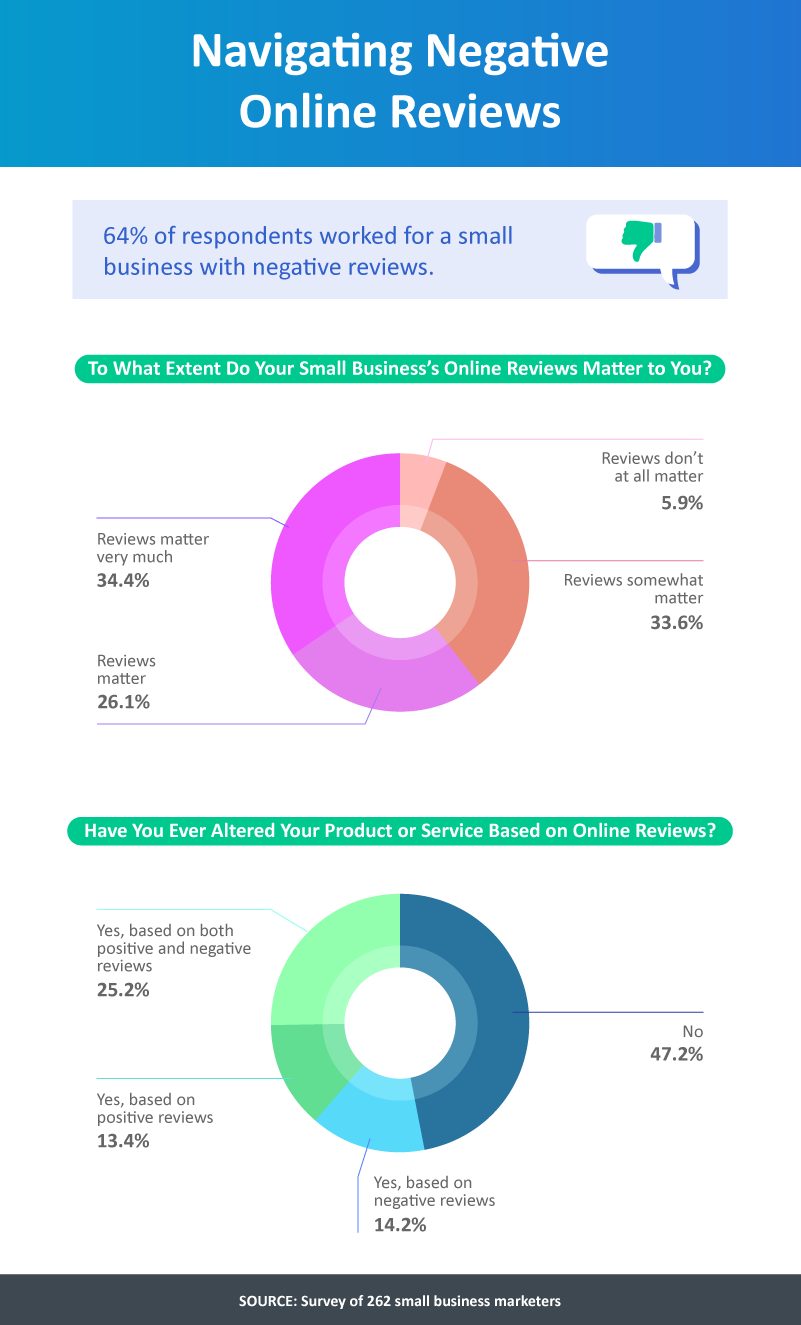
A customer who has a bad experience is likely to share that experience by leaving a negative review. A customer who has a great experience, however, is unlikely to leave a positive review. Of course, this presents an unfair challenge to even the best of businesses, which our respondents divulged. Sixty-four percent of those we asked currently worked for companies with negative online reviews. And only 5.9% chose not to concern themselves with these reviews.
Most marketers were proactive about negative reviews, actually using them to improve their products. Many – 26% – even believed the negative online reviews they received were justified. And nearly 53% had altered their products or services in response to an online review, whether positive or negative.
Recapping Reviews
Given that businesses are often adapting and responding in helpful ways to their customers, leaving a review should be encouraged. Just make sure your criticism is constructive so that action can be taken. And when you do have a positive experience, also share it!
Positive experiences and reviews are important to any business, but particularly so with businesses whose services may be difficult to understand, like SEO. SEO is a complicated yet incredibly valuable component to your online business, so make sure you’ve found the right people for the job. Start by visiting BestSEOCompanies.com, where the top SEO companies are compared in order to help you choose the right match for you and your business.
Methodology and Limitations
For this analysis, we ran 2.7 million reviews through Fakespot.com to identify the percentage of unreliable online reviews across multiple product and service categories. A total of 389 products were submitted to the analyzer with at least 25 unique items per category. Categories with over 100,000 online reviews were shown. Fakespot uses an algorithm that employs machine learning to review and rate the authenticity of online reviews. The authenticity is based on but not limited to various criteria, such as suspicious patterns and incentivized reviews.
Additionally, we administered two online surveys via Amazon Mechanical Turk to further explore this topic. Altogether, 1,024 people participated in our survey. The first group consisted of 762 online consumers, and the second survey was sent out to 262 people who were involved in the marketing efforts of a small business. Respondents ranged in age from 18 to 77 with an average age of 38 and a standard deviation of 12. The survey that focused on online consumers had a margin of error of plus or minus 4% at a 95% confidence interval. The questionnaire geared toward small business employees had a margin of error of plus or minus 6% at a 95% confidence interval. U.S. population data were pulled from the U.S. Census Bureau, and the number of small business employees was from the Small Business Administration.
To ensure data accuracy, qualifiers and attention-check questions were used to reach the target population of each survey and disqualify those who failed to read the questions and answers in their entirety. The main limitation of these data is that the surveys relied on self-reported answers, which can encounter issues such as telescoping, exaggeration, recency bias, and attribution. To minimize these influences, procedures were followed throughout the questionnaire design, response collection, and data analysis. Another limitation is that Fakespot relies on artificial intelligence, which learns from available data.
Fair Use Statement
Consider yourself something of an online reviewer? You’re free to share (and review!) this article online for noncommercial purposes, but be sure to link back to this page to provide credit where it’s due.
 Best SEO Companies
Best SEO Companies Best SEO Companies
Best SEO Companies